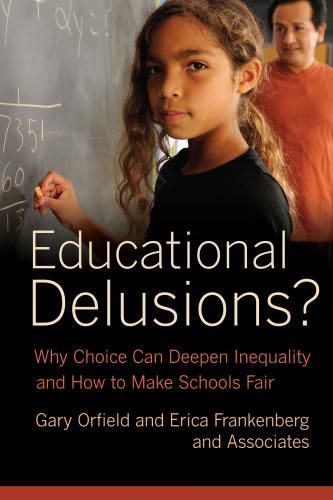The book concludes with a broader view of research on choice and diversity and the conditions for achieving and maximizing the potential benefits of diverse schools. It points to the possible contributions that can be made by federal and state actors, district- and school-level leaders, community and civil rights organizations, and external researchers. A central theme of the book is that the kind of choice offered and the terms under which it is implemented matter greatly in determining its consequences, and unless policy explicitly takes the race of students into account and has a goal of integration, it is likely to make segregation worse and opportunity more unequal. It would be a tragic outcome if a movement justified as an expansion of choices for the families that need them the most were to deepen separation and diminish opportunities. There is disturbing evidence that this is happening today. Yet there is a much richer and more beneficial practice of choice possible, deeply rooted in the experiences of the civil rights era, and there are ways to use its power for much more positive outcomes, for students, families, and our society.
NOTES
1. U.S. Census Bureau, Statistical Abstract of the United States: 2012, table 253.
2. Bartels, Unequal Democracy: The Political Economy of the New Gilded Age.
3. Henig, Rethinking School Choice: The Limits of the Market Metaphor, 231.
4. Schwartz et al., “Goals 2000 and the Standards Movement.”
5. Thernstrom and Thernstrom, No Excuses: Closing the Racial Gap in Learning, 265.
6. Scott, “School Choice as a Civil Right: The Political Construction of a Claim and Implications for School Desegregation.”
7. Dillon and Schemo, “Charter Schools Fall Short in Public Schools Matchup: U.S. Reports Findings of Study in 5 States.”
8. Washington Post, "Obama Delivers Remarks on Education at National Urban League: Speech Transcript.”
9. U.S. Department of Education, “President Obama, Secretary Duncan Announce Race to the Top.”
10. Bush, first State of the Union address.
11. Clinton, eighth State of the Union address.
12. Carnoy et al., The Charter School Dust-Up: Examining the Evidence on Enrollment and Achievement.
13. National Center for Education Statistics, NAEP 2008: Trends in Academic Progress, Reading 1971-2008, Mathematics 1973-2008; Education Week, Diplomas Count, June 2011.
14. Fuller et al., Is the No Child Left Behind Act Working?
15. Prevention Institute for the Center for Health Improvement, “Nutrition Policy Profiles: Supermarket Access in Low-Income Communities.”
16. Eaton, The Other Boston Busing Story, 4-6.
17. Sunderman, Kim, and Orfield, NCLB Meets School Realities: Lessons from the Field.
18. Apart from a very small proportion who are approved for homeschooling.
19. For more on Milton Friedman, see chapter 2. For Alum Rock, see Bridge and Blackman, Family Choice in Schooling.
20. Brown v. Board of Education (1954).
21. Brown v. Board of Education (1955).
22. Briggs v. Elliott.
23. G. Orfield, The Reconstruction of Southern Education: The Schools and the 1964 Civil Rights Act, 20.
24. U.S. Commission on Civil Rights, Southern School Desegregation 1966-67.
25. U.S. Office of Education, “General Statement of Policies,” school desegregation guidelines, April 1965.
26. Orfield, The Reconstruction of Southern Education.
27. Bass, Unlikely Heroes.
28. Green et al. v. County School Board of New Kent County, Virginia, et al.
29. G. Orfield, Must We Bus?: Segregated Schools and National Policy, 19-24.
30. Shelly v. Kraemer.
31. Fossey, School Choice in Massachusetts: Will It Help Schools Improve?
32. Griffin v. County School Board of Prince Edward County.
33. Griffin v. County School Board, oral argument (in part 2 at www.oyez.org/cases/1960-1969/1963/1963_592/).
34. Lewis, Portrait of a Decade: The Second American Revolution.
35. Keyes v. Denver School District No. 1.
36. Center for National Policy Review, Catholic University Law School, Why Must Northern School Systems Desegregate? A Summary of Federal Court Decisions in Recent Cases.
37. Milliken v. Bradley.
38. Bureau of Equal Educational Opportunities, Massachusetts Department of Education, Schools and Programs of Choice: Voluntary Desegregation in Massachusetts.
39. Yu and Taylor, eds., Difficult Choices: Do Magnet Schools Serve Children in Need?, 9.
40. Betts et al., “Does School Choice Work? Effects on Student Integration and Achievement” Bifulco, Cobb, and Bell, “Can Interdistrict Choice Boost Student Achievement? The Case of Connecticut's Interdistrict Magnet School Program” Gamoran, “Student Achievement in Public Magnet, Public Comprehensive, and Private City High Schools.”
41. Eaton, “Slipping toward Segregation” Eaton and Crutcher, “Magnets, Media and Mirages.”
42. Board of Education of Oklahoma City Public Schools v. Dowell; Boger and Orfield, eds., School Resegregation, Must the South Turn Back?
43. Tuttle v. Arlington County School Board; Eisenberg v. Montgomery County Public Schools.
44. Smrekar and Goldring, School Choice in Urban America: Magnet Schools and the Pursuit of Equity; Metz, Different by Design.
45. Wells and Crain, Stepping Over the Color Line: African-American Students in White Suburban Schools; Heaney and Uchitelle, Unending Struggle: The Long Road to an Equal Education in St. Louis.
46. Willie, Edwards, and Alves, Student Diversity, Choice and School Improvement.
47. Weaver, “Controlled Choice: An Alternative School Choice Plan.”
48. Willie, Edwards, and Alves, Student Diversity.
49. Thernstrom and Thernstrom, No Excuses.
50. Chubb and Moe, Politics, Markets, and America's Schools.
51. Gates, remarks at the National Charter Schools Conference.
52. Frahm, “Charter Schools: A Debate over Integration and Education.”
53. Nathan, Charter Schools: Creating Hope and Opportunity for American Education.
54. See, for example, the October 31, 1994, Time magazine cover, which read, “New Hope For Public Schools: In a grassroots revolt, parents and teachers are seizing control of public education.”
55. Center for Research on Educational Outcomes, Multiple Choice: Charter School Performance in Sixteen States.
56. 1991 Omnibus K-12 Education Finance Bill (House File 700/Senate File 467, Laws of Minnesota 1991, chapter 265, article 9, section 3).
57. Center for Educational Reform, “National Charter School and Enrollment Statistics 2009, 2010.”
58. Hess, “Race to the Top? The Promise—and Challenges—of Expanding the Reach of Charter Schools.”
59. See, e.g., Coleman, Hoffer, and Kilgore, “Cognitive Outcomes in Public and Private Schools” Bryk,
